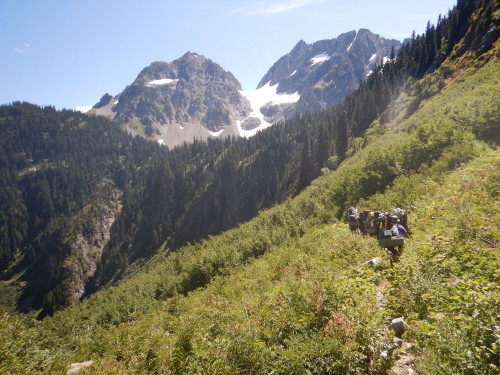Youth Leadership Adventures 2015: A Report from Ross Lake
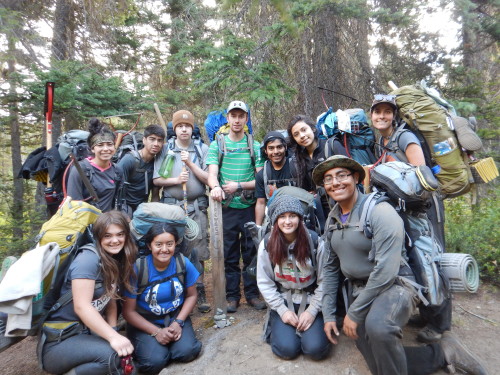
By Sabrina Freedman
Editors note: To put into context the Youth Leadership Conference held at our Environmental Learning Center from November 6-8, this article was written by one of our Youth Leadership Adventure leaders, Sabrina Freedman. In it, she reflects on the growth she witnessed in her student trail group during their backcountry journey.
A remote basin in North Cascades National Park sits below two of its tallest peaks. Goode and Logan mountains are heavily glaciated, and are a remarkable and remote destination to park visitors and students on a Youth Leadership Adventures trip. This basin is so remote, that it is home to a wolverine monitoring station and a three-mile trail that terminates in high meadows with herbaceous plants and black bears galore.
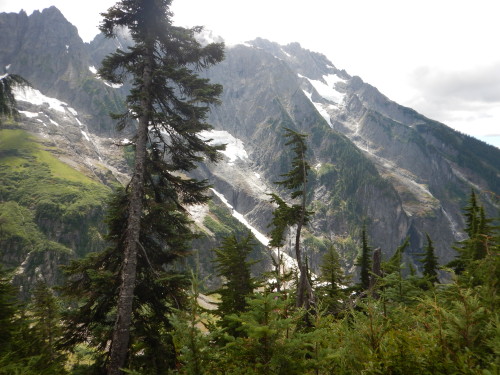
Basin between Goode and Logan mountains.
The group of students on an 11-day backpacking adventure was unsure if they would find habitat for themselves in such a wild place. The nine students, all rising juniors, seniors or recent high school graduates had signed up for a 16 day field course focused in learning about climate science and sustainable practices. The students were from as far as Astoria, Oregon though many were from the Skagit and Nooksack flats in towns such as Mt. Vernon, La Conner, Sumas and Saxon.
Many students came for the great views and to have fun outside but also to complete their senior projects and to learn more about our changing climate. As the new group got together on the first day to hike over Cascade Pass with a collective 450 pounds of gear and food, they were amazed both by the beauty around them and by their personal strength. They were especially mesmerized by the glaciers.
To begin their quest in learning about our changing climate, students met with Jon Riedel, the National Park Geomorphologist. After learning about the diminishing sliding ice and rocky blocks on these high peaks, the group named themselves the Glacier Gazers. This lent itself nicely to the call and response – Glacier! – Gazers!
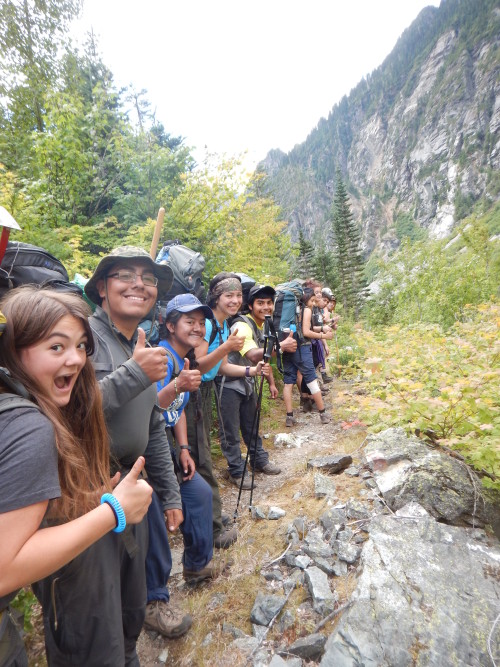
Glazier Gazer on the trail!
Over the next few days, students became proficient at leading their peers down the trail until reaching North Fork campsite. If you have hiked from highway 20 to Stehekin (south on the Pacific Crest Trail), you might know the trail sign leading north to a campsite just before crossing Bridge Creek. The students worked tenaciously to restore one of the National Park’s overused areas.
With the help of a student leader as the project manager, everyone moved small stones and rotting wooden debris (detritus) to the highly impacted area. As the students gradually covered exposed areas to help protect the ecosystem, they slowly gained an understanding that certain areas are designed for human impact in the National Park while others are intended to be protected for other members of the biotic community.
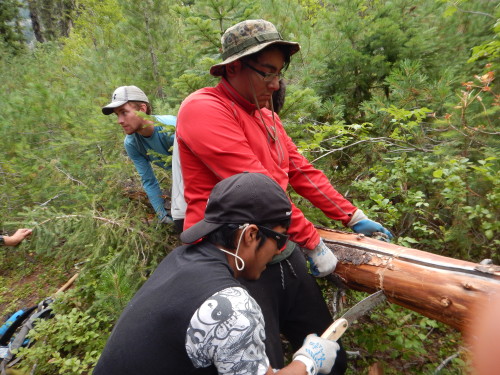
Students clearing an overgrown trail.
Finally, it was time to head up toward Grizzly Creek. With lighter backpacks and a greater understanding for the National Park, the Glacier Gazers again saw their namesake. It was in this U shaped valley that the group worked hard to open overgrown trails, learn about the Greenhouse Effect and Carbon Cycle, and bond as a community. Armed with great communication skills and the ability to travel comfortably on the trail, the group was tasked with arriving at their next campsite without instructors.
Hiking through the basin.
As one of their instructors, I can’t quite speak for what happened on that day as I was not present. But;
- I can speak for their loud cheers when they left for their hiking day in the morning.
- I can note that I did not find a single piece of trash or personal belongings left in camp or along the trail.
- I can even report that some hikers took their picture at lunch and reported when seeing me and my co-leader that they appeared happy and healthy.
- I was most surprised when I arrived on the Pacific Crest Trail and found that an overgrown section had been brushed.
My co-leader and I decided the Park’s trail crew must be staying nearby. It wasn’t until that evening when I snuck into camp to make sure everyone was alright when I watched these dedicated students doing more brushing near camp that I realized it had also been them earlier on the trail. When the dinner team called, the Glacier Gazers brought their tools to the campsite and ate dinner without their instructors. They had spent the day spectacularly practicing all of the skills we had been teaching them.
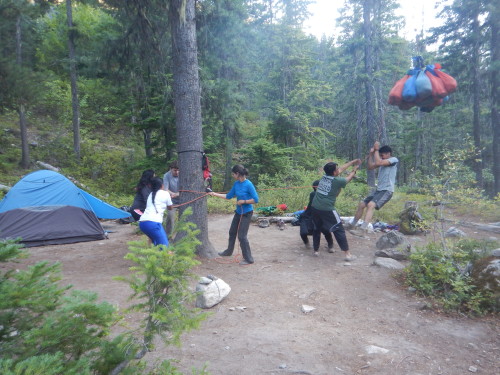
Working together to hang food.
And though we were not present to witness it all, at the end of the day, they had shown us they were a competent, thoughtful backpacking team that could rise to whatever challenge was given to them.


